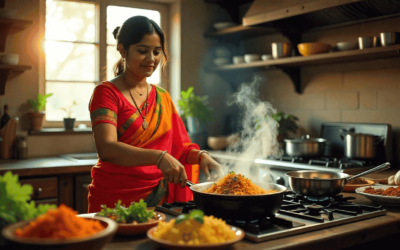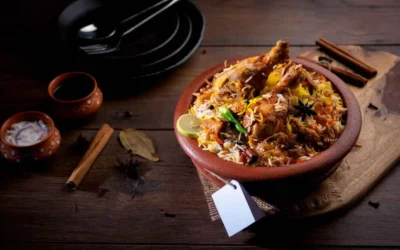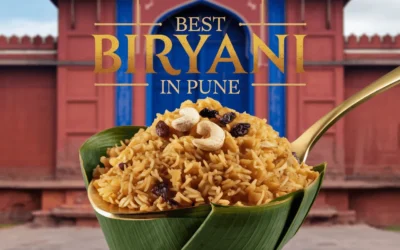50 Biryani Varieties from Around the World: The Ultimate Guide for Food Lovers

Biryani isn’t just a dish; it’s an emotion that transcends borders. From the bustling streets of Hyderabad to the serene shores of Zanzibar, biryani has found its way into hearts and homes worldwide. This aromatic rice dish, with its medley of spices, tender meat, and perfectly cooked grains, is a testament to culinary innovation and cultural diversity.
While biryani’s roots trace back to Persia and the Indian subcontinent, it has evolved over centuries, taking on unique flavours and techniques in every region it has touched. Today, we explore 50 incredible varieties of biryani that reflect the richness of their origins and showcase the versatility of this globally loved dish.
Whether you’re a biryani purist or an adventurous foodie, this guide promises to take you on a flavourful journey across continents. Let’s dive in!
Indian Biryani Varieties (Expanded List)
India’s diverse culinary landscape has given rise to countless biryani varieties, each with unique regional flavours, ingredients, and preparation styles. Here’s an extensive list of the most notable biryani types across the country:
- Hyderabadi Biryani
- Lucknowi (Awadhi) Biryani
- Kolkata Biryani
- Malabar (Thalassery) Biryani
- Dindigul Biryani
- Ambur Biryani
- Chettinad Biryani
- Tahari Biryani
- Kalyani Biryani
- Bombay Biryani
- Bhatkali Biryani
- Memoni Biryani
- Beary Biryani
- Kozhikode (Calicut) Biryani
Additional Regional and Lesser-Known Indian Biryani Varieties
- Mangalore Biryani – A Karnataka speciality with bold coastal flavours and the use of coconut.
- Goan Fish Biryani – A unique seafood biryani with the tanginess of vinegar and Goan spices.
- Nagpur Biryani – Known for its fiery spice level and distinct use of dry coconut masala.
- Kashmiri Biryani – A mildly spiced biryani with saffron, dry fruits, and tender lamb.
- Sindi Biryani – Popular in parts of Rajasthan, featuring mutton, yoghurt, and fragrant spices.
- Biryani from Uttar Pradesh – Simple yet rich, focusing on slow-cooked flavours and ghee.
- Jaipur Biryani – Incorporates the royal flavours of Rajasthani cuisine with a blend of local spices.
- Andhra Biryani – Features fiery chillies, tamarind, and rich flavours, often served with spicy gravy.
- Tamil Muslim Biryani – Known for its aromatic spices, green chillies, and distinct preparation.
- Bamboo Biryani (Assamese Style) – Cooked in bamboo tubes for a smoky flavour, popular in the Northeast.
- Kerala Prawns Biryani – A seafood delight combining fresh prawns with Kerala’s signature spices.
- Chennai Biryani – A quick and flavourful biryani with bold spices and short-grained rice.
- Rajput Biryani – Inspired by the royal kitchens of Rajasthan, featuring game meat like quail or venison.
- Coorgi Pandi Biryani – From the hilly region of Coorg, this biryani uses pork and robust spices.
- Jodhpuri Biryani – A Rajasthani biryani made with red chillies, garlic, and a potent spice mix.
- Vegetable Biryani – A pan-Indian favourite featuring assorted vegetables, saffron, and mild spices.
🍛 Get the Ultimate Guide!
Click here to download your FREE PDF: ‘30 Varieties of Biryani in India.’
30 Types of Biryani in India: Hyderabadi, Lucknowi, Kolkata, Malabar, and More
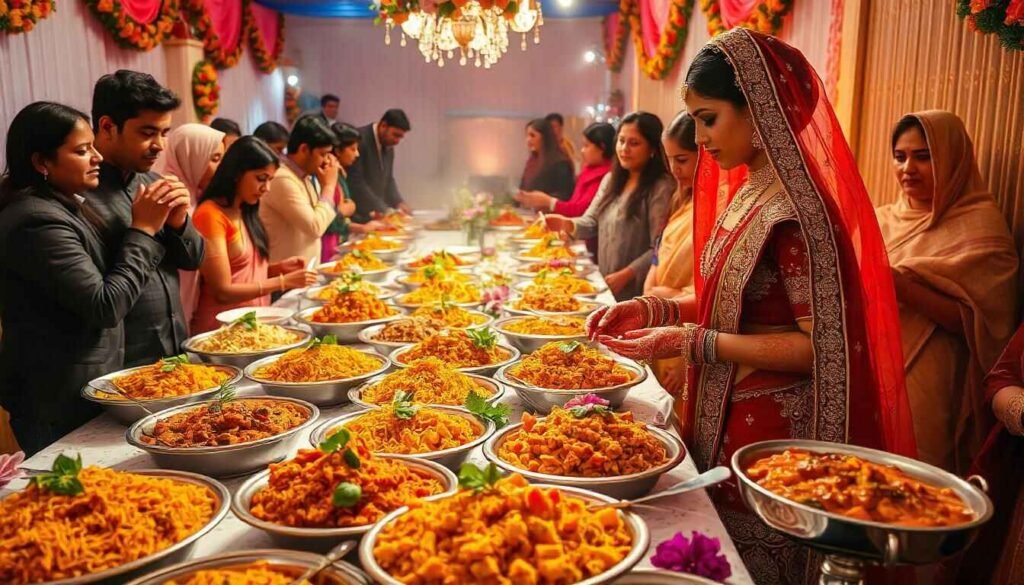 India’s rich culinary heritage has given rise to 30 distinct types of biryani, each representing the flavours and traditions of its region. From the royal Awadhi kitchens to the fiery streets of Tamil Nadu, here’s a comprehensive look at the biryanis that define Indian cuisine.
India’s rich culinary heritage has given rise to 30 distinct types of biryani, each representing the flavours and traditions of its region. From the royal Awadhi kitchens to the fiery streets of Tamil Nadu, here’s a comprehensive look at the biryanis that define Indian cuisine.
Hyderabadi Biryani
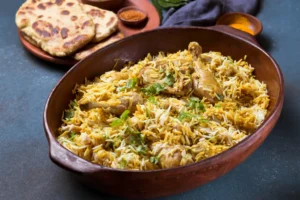 The crown jewel of Indian biryanis, Hyderabadi biryani, is an iconic dish known for its bold flavours, tender marinated meat, and fragrant Basmati rice. Cooked using the dum pukht method, this biryani is a sensory delight with its perfect blend of saffron, fried onions, and mint.
The crown jewel of Indian biryanis, Hyderabadi biryani, is an iconic dish known for its bold flavours, tender marinated meat, and fragrant Basmati rice. Cooked using the dum pukht method, this biryani is a sensory delight with its perfect blend of saffron, fried onions, and mint.
Lucknowi (Awadhi) Biryani
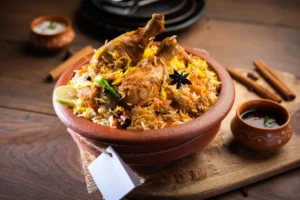 Reflecting the royal heritage of Awadh, this biryani is cooked with precision and subtlety. The meat and rice are separately cooked and layered in a handi, infused with saffron and aromatic spices such as cardamom and cinnamon.
Reflecting the royal heritage of Awadh, this biryani is cooked with precision and subtlety. The meat and rice are separately cooked and layered in a handi, infused with saffron and aromatic spices such as cardamom and cinnamon.
Kolkata Biryani
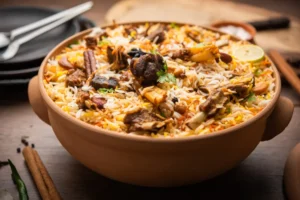 Known for its unique inclusion of potatoes and boiled eggs, Kolkata biryani has a lighter spice mix and a subtle sweetness. Using rose water and kewra essence gives it a distinct aroma that sets it apart.
Known for its unique inclusion of potatoes and boiled eggs, Kolkata biryani has a lighter spice mix and a subtle sweetness. Using rose water and kewra essence gives it a distinct aroma that sets it apart.
Malabar (Thalassery) Biryani
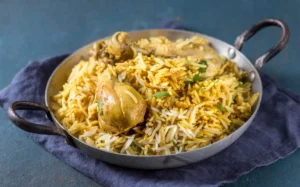 This Kerala’s Malabar coast biryani uses Jeerakasala rice, cashews, and raisins for a sweet, spicy flavour profile. Cooked in ghee and coconut oil, it’s often made with chicken, mutton, or seafood.
This Kerala’s Malabar coast biryani uses Jeerakasala rice, cashews, and raisins for a sweet, spicy flavour profile. Cooked in ghee and coconut oil, it’s often made with chicken, mutton, or seafood.
Dindigul Biryani
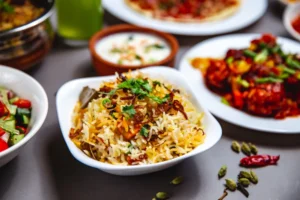 This Tamil Nadu favourite is known for its tangy taste, achieved through curd and lemon juice. Made with Seeraga Samba rice and tender goat meat, it’s a fiery delight for spice enthusiasts.
This Tamil Nadu favourite is known for its tangy taste, achieved through curd and lemon juice. Made with Seeraga Samba rice and tender goat meat, it’s a fiery delight for spice enthusiasts.
Ambur Biryani
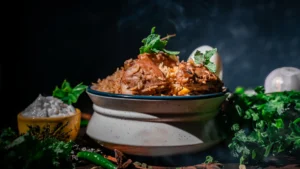 Originating in Tamil Nadu’s Vellore district, this biryani combines marinated meat with Seeraga Samba rice and fiery chilli paste. It’s often served with ennai kathirikai, a rich brinjal curry.
Originating in Tamil Nadu’s Vellore district, this biryani combines marinated meat with Seeraga Samba rice and fiery chilli paste. It’s often served with ennai kathirikai, a rich brinjal curry.
Chettinad Biryani
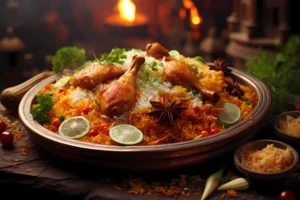 Spicy and aromatic, this Tamil Nadu biryani reflects Chettinad’s rich culinary heritage. It features a unique blend of spices like fennel and star anise and is often cooked with Seeraga Samba rice and coconut milk.
Spicy and aromatic, this Tamil Nadu biryani reflects Chettinad’s rich culinary heritage. It features a unique blend of spices like fennel and star anise and is often cooked with Seeraga Samba rice and coconut milk.
Tahari Biryani
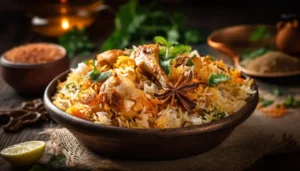 A vegetarian version created during the Mughal era, Tahari biryani replaces meat with potatoes and other vegetables. It retains the classic biryani flavours, making it a favourite among vegetarians.
A vegetarian version created during the Mughal era, Tahari biryani replaces meat with potatoes and other vegetables. It retains the classic biryani flavours, making it a favourite among vegetarians.
Kalyani Biryani
Known as the “poor man’s Hyderabadi biryani,” Kalyani is made with buffalo meat, tomatoes, and a tangy spice mix. Despite its humble origins, it boasts bold and delicious flavours.
Bombay Biryani
This biryani is a Mumbai speciality that stands out with its fried potatoes, dried plums, and tangy flavour. It’s a sweet and spicy delight, often cooked with mutton or chicken.
Bhatkali Biryani
This biryani, from Karnataka’s coastal town of Bhatkal, has a fiery flavour from green chillies and onions. Its rich and spicy layers reflect its Persian influences.
Memoni Biryani
A Gujarat-Sindh favourite, Memoni biryani is intensely flavourful. Fewer tomatoes and vibrant spices enhance the meat’s natural colour and taste. Lamb and fried onions are key ingredients.
Beary Biryani
This Karnataka speciality uses green chillies, coconut milk, and fragrant rice. It’s a mild yet flavourful biryani popular among the Beary Muslim community.
Kozhikode (Calicut) Biryani
A classic from Kerala’s Malabar region, this biryani blends Arab and Indian influences. It’s rich and aromatic, often cooked with exotic spices and tender meat.
Mangalore Biryani
Known for its coastal flavours, Mangalore biryani incorporates coconut, ghee, and local spices. It’s a flavourful delight that reflects Karnataka’s culinary traditions.
Goan Fish Biryani
A unique seafood biryani that combines Goan spices with a tangy twist from vinegar. It’s a must-try for seafood lovers.
Nagpur Biryani
Fiery and flavourful, Nagpur biryani is known for its distinct dry coconut masala. It’s a spicy treat perfect for those who love bold flavours.
Kashmiri Biryani
This mild and aromatic biryani features saffron, dry fruits, and tender lamb. It reflects the delicate and rich flavours of Kashmiri cuisine.
Sindi Biryani
Popular in parts of Rajasthan, Sindi biryani is a hearty and flavourful dish made with mutton, yoghurt, and aromatic spices.
Andhra Biryani
A fiery biryani that showcases the bold flavours of Andhra Pradesh. It’s often cooked with green chillies and tamarind for a tangy, spicy kick.
Tamil Muslim Biryani
Aromatic and flavourful, this biryani uses green chillies, tomatoes, and yoghurt to create a rich and spicy dish.
Bamboo Biryani (Assamese Style)
Cooked inside bamboo tubes, this biryani has a smoky flavour and a unique texture. It’s a popular dish in the Northeast.
Kerala Prawns Biryani
This biryani is a coastal delight. It combines fresh prawns with fragrant spices and coconut milk, making it rich, creamy, and irresistible.
Chennai Biryani
A quick and bold biryani from Tamil Nadu, it’s known for its strong spices and short-grained rice.
Rajput Biryani
Inspired by Rajasthan’s royal kitchens, this biryani often features game meat like quail or venison, with a rich and spicy flavour profile.
Coorgi Pandi Biryani
This biryani from Coorg in Karnataka is made with pork and a robust blend of spices. It’s a unique and flavourful option.
Jodhpuri Biryani
A Rajasthani biryani featuring red chillies, garlic, and a potent spice mix. It’s bold and hearty, perfect for spice lovers.
Vegetable Biryani
A pan-Indian favorite, vegetable biryani is made with various vegetables, saffron, and mild spices. It’s perfect for vegetarians seeking a flavourful option.
Middle Eastern Biryani Varieties
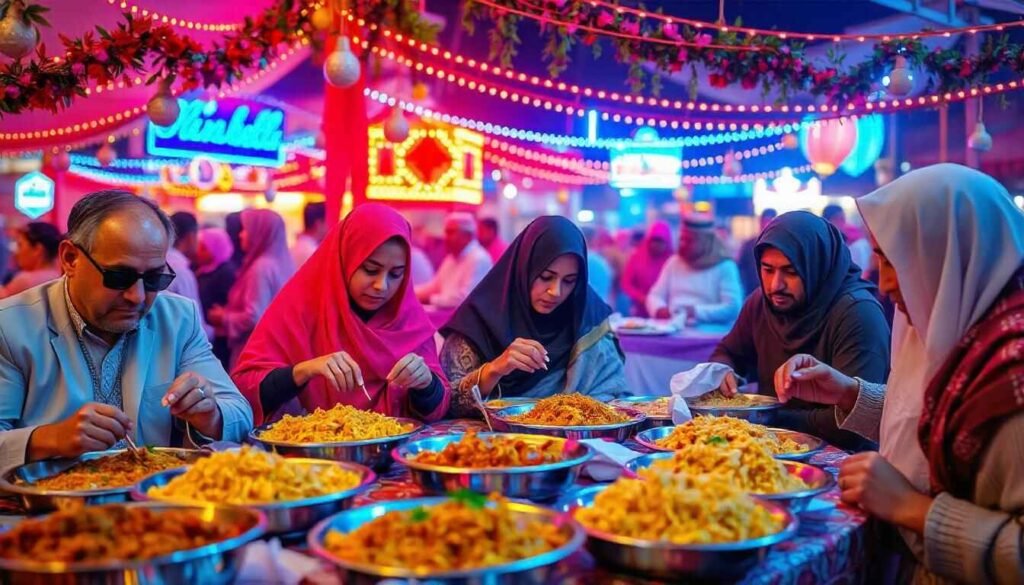 The Middle East, often considered the origin point of biryani, has influenced its flavours and techniques significantly. While “biryani” might not be as standard in the region, dishes with similar elements—spiced rice, slow-cooked meat, and aromatic herbs—are a staple of Middle Eastern cuisine. Let’s explore some of the popular varieties inspired by Middle Eastern flavours:
The Middle East, often considered the origin point of biryani, has influenced its flavours and techniques significantly. While “biryani” might not be as standard in the region, dishes with similar elements—spiced rice, slow-cooked meat, and aromatic herbs—are a staple of Middle Eastern cuisine. Let’s explore some of the popular varieties inspired by Middle Eastern flavours:
Persian Biryani
As the historical precursor to Indian biryani, Persian biryani is more of a layered pilaf than what we typically think of as biryani. Baghali Polo uses fragrant basmati rice, slow-cooked lamb or chicken, and dill for a refreshing flavour. For a rich, golden hue, the dish is often garnished with saffron and caramelized onions.
Omani Biryani
Oman’s biryani, or maqbous, is a vibrant rice dish with dried lime, saffron, and local spices. What sets it apart is the smoky aroma imparted by burning charcoal placed in the cooking pot during preparation. This biryani is often served with spiced meat and a side of yoghurt or pickled vegetables.
Arabic Bukhari Biryani
 Bukhari rice is popular in Saudi Arabia. It is a simplified, mildly spiced dish resembling biryani. It’s often made with long-grain rice, tender chicken or lamb, and a blend of cardamom, cloves, and cinnamon. The dish is typically paired with tomato-based salsa or yoghurt.
Bukhari rice is popular in Saudi Arabia. It is a simplified, mildly spiced dish resembling biryani. It’s often made with long-grain rice, tender chicken or lamb, and a blend of cardamom, cloves, and cinnamon. The dish is typically paired with tomato-based salsa or yoghurt.
Turkish Pilaf (Etli Pilav)
While not a traditional biryani, Turkey’s Etli Pilav is a close cousin. It features rice cooked with lamb, chickpeas, and nuts. The flavours are mild, but using butter and dried fruits gives it a rich, comforting profile.
Emirati Biryani
In the United Arab Emirates, biryani has taken on a unique identity. Its meat (often goat or chicken) is marinated in yoghurt and saffron. The rice is cooked with dried lemons and rose water, giving it a delicate yet fragrant aroma.
Yemeni Mandi
Yemen’s mandi is a spiced rice and meat dish cooked in an underground clay oven, giving it a smoky flavour. The rice is spiced with cloves, cardamom, and bay leaves, while the meat, often lamb or chicken, is seasoned with a tangy blend of spices.
Kuwaiti Machboos
Like biryani, machboos uses spiced rice cooked with meat, often including dried fruits like raisins. It’s garnished with nuts and served with a side of tomato chutney for a perfect balance of sweet and savory.
Asian Biryani Varieties
 With its rich culinary diversity, Asia has embraced biryani and adapted it to its regional tastes and ingredients. From the tangy flavours of Sri Lanka to the spicy renditions of Southeast Asia, biryani in Asia is as vibrant and varied as its people. Let’s explore the standout varieties:
With its rich culinary diversity, Asia has embraced biryani and adapted it to its regional tastes and ingredients. From the tangy flavours of Sri Lanka to the spicy renditions of Southeast Asia, biryani in Asia is as vibrant and varied as its people. Let’s explore the standout varieties:
Pakistani Sindhi Biryani
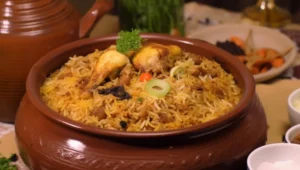 A hallmark of Pakistani cuisine, Sindhi biryani is known for its bold and tangy flavours. The rice is layered with spiced meat, potatoes, and yoghurt, while dried plums and green chilies add a sweet and spicy balance. The generous use of garam masala gives it a fragrant kick.
A hallmark of Pakistani cuisine, Sindhi biryani is known for its bold and tangy flavours. The rice is layered with spiced meat, potatoes, and yoghurt, while dried plums and green chilies add a sweet and spicy balance. The generous use of garam masala gives it a fragrant kick.
Bangladeshi Kacchi Biryani
In Bangladesh, kacchi biryani is a beloved delicacy, especially during celebrations. The raw marinated meat, often mutton or beef, is cooked with fragrant Basmati rice and potatoes in a sealed pot. The slow-cooking process infuses the dish with layers of flavour, making it incredibly rich and aromatic.
Sri Lankan Biryani
Sri Lankan biryani, or biryani, is a spicier and more robust version of the dish. It features fried onions, cashews, and raisins and is often served with sambal (spicy coconut relish) and boiled eggs. The rice is cooked with bold spices and sometimes even coconut milk, adding a tropical twist.
Indonesian Nasi Kebuli
In Indonesia, biryani takes the form of nasi kabuki, a dish influenced by Middle Eastern and Indian cuisines. It’s rich and aromatic, cooked with goat meat, ghee, and spices like cardamom and nutmeg. It’s often garnished with fried shallots and served with pickles or sambal (chilli paste).
Thai Khao Mok Gai
Thailand’s version of biryani, khao mok gai, is a fragrant rice dish cooked with chicken, turmeric, and coconut milk. The flavours are mild yet delicious, and it is often paired with a tangy dipping sauce made of lime, chillies, and garlic.
Malaysian Biryani (Nasi Beriani)
In Malaysia, nasi biryani is a popular wedding dish. It’s typically cooked with mutton, chicken, or beef and flavoured with ghee, cinnamon, and cloves. Fried shallots and boiled eggs as garnishes add an extra layer of indulgence.
Afghan Biryani
Afghan biryani is a hearty dish that leans heavily on dried fruits and nuts, giving it a sweet undertone. The rice is cooked with tender lamb or chicken, saffron, and mild spices, making it less fiery but intensely flavourful.
Filipino Arroz Valenciana
Inspired by Spanish and Asian cuisines, arroz valenciana in the Philippines is a festive rice dish similar to biryani. It combines glutinous rice with coconut milk, turmeric, chicken, and chorizo, offering a unique texture and taste.
African Biryani Varieties
 Africa’s vibrant cultures and diverse flavours have added a unique twist to biryani. From the coastal influences of Zanzibar to the fusion flavours of Cape Malay cuisine, biryani has been embraced and reimagined in exciting ways across the continent.
Africa’s vibrant cultures and diverse flavours have added a unique twist to biryani. From the coastal influences of Zanzibar to the fusion flavours of Cape Malay cuisine, biryani has been embraced and reimagined in exciting ways across the continent.
South African Cape Malay Biryani
This biryani is a delightful fusion of Indian and African influences brought to South Africa by Indian labourers during the colonial era. Cape Malay biryani is distinguished by its rich use of spices like turmeric, cinnamon, and cloves combined with meat (usually lamb or chicken) and vegetables. Raisins and fried onions add a touch of sweetness, while sambal (a spicy chilli sauce) accompanies the dish for an extra kick.
Zanzibar Biryani
Hailing from the beautiful island of Zanzibar, this biryani reflects its rich cultural history. Influenced by Arab and Indian traders, Zanzibar biryani is known for its bold spices, coconut milk, and the use of dried fruits like apricots and raisins. The rice is fragrant and mildly spiced, perfectly complementing the tender meat.
Somali Bariis Iskukaris
Often called Somali biryani, bariis iskukaris is a rice dish that is simpler yet packed with flavour. Cooked with lamb or chicken, it uses a mix of spices like cumin, cardamom, and cloves and is often paired with bananas on the side—a unique Somali touch.
Kenyan Biryani
In Kenya, biryani is a festive dish served during celebrations. The Kenyan version includes a heavily spiced curry made with chicken or goat, layered with aromatic rice. The curry often has tomatoes, garlic, and ginger, giving it a rich and hearty flavour.
Egyptian Koshari Biryani
While not a traditional biryani, Egypt’s kosher version has some similarities. It combines rice with lentils, chickpeas, and a tomato-based sauce. Though it leans more towards a pilaf, its layered preparation and flavours make it a delightful cousin to biryani.
Tanzanian Biryani
Tanzanian biryani reflects the Swahili coast’s love for spices and coconut. The rice is cooked with turmeric, cardamom, and cinnamon, while the meat is marinated in a spicy, yoghurt-based mixture. It’s often served with kachumbari, a tangy tomato and onion salad.
European and Global Twists on Biryani
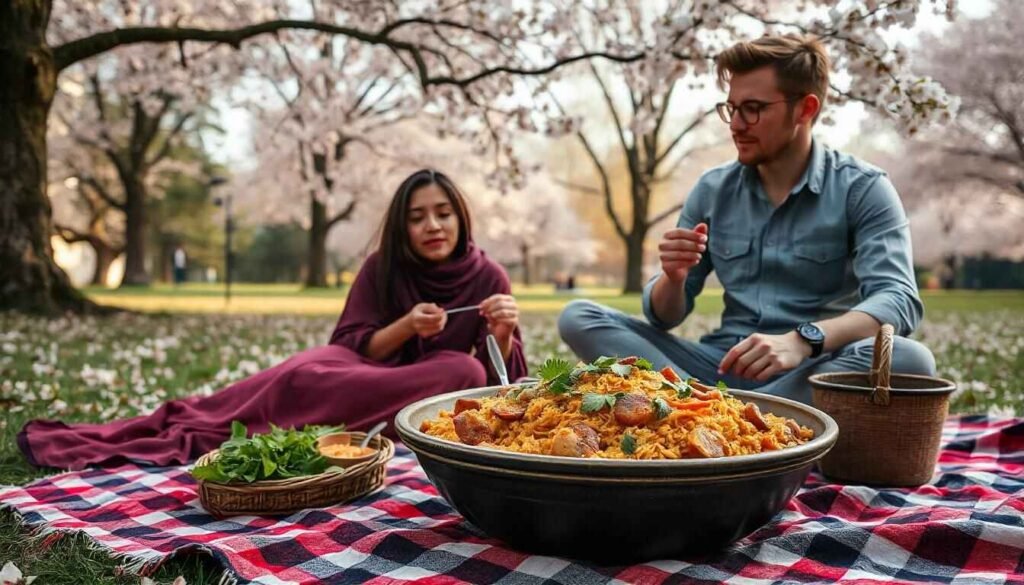 As biryani gained global popularity, chefs and food lovers across continents added their creative twists to this beloved dish. From hearty British pub adaptations to modern fusion creations, these versions showcase how biryani has evolved in new culinary landscapes.
As biryani gained global popularity, chefs and food lovers across continents added their creative twists to this beloved dish. From hearty British pub adaptations to modern fusion creations, these versions showcase how biryani has evolved in new culinary landscapes.
British Fusion Biryani
Biryani is a staple in curry houses and restaurants in the UK, where it has been adapted to suit local tastes. Often made with a milder spice blend and a creamy tomato base, British biryani is a comforting and hearty meal. Vegetarian and vegan versions have also gained popularity, featuring chickpeas, paneer, or tofu as protein alternatives.
Caribbean Biryani
Caribbean biryani is a fusion of Indian and local island flavours. Jerk seasoning, coconut milk, and Scotch bonnet peppers give this version a spicy and smoky kick. It’s often served with fried plantains or mango salsa for a tropical twist.
American Tex-Mex Biryani
In the United States, biryani has embraced Tex-Mex influences. Think biryani with layers of spiced ground beef, jalapeños, cheese, and sour cream. This fusion dish is a bold and flavourful innovation that combines the best of both cuisines.
Japanese Curry Biryani
Japan has added its unique touch to biryani by blending it with its popular curry rice. Japanese curry biryani features mild, sweet curry layered with rice and breaded chicken or pork cutlets. The dish is comfort food with creamy textures and rich flavours.
Italian Risotto-Style Biryani
In Italy, biryani-inspired risottos have made their way onto menus. This risotto combines slow-cooking techniques with the spices and flavours of biryani. This version often includes seafood or chicken, saffron, and a drizzle of olive oil.
Australian Lamb Biryani
Biryani is a popular feature in Australia at food festivals and fine-dining restaurants. Lamb, a widely loved protein, is often the star, paired with aromatic spices and long-grain rice. Some chefs add native ingredients like lemon myrtle or macadamia nuts for a local twist.
French Duck Confit Biryani
French chefs have reimagined biryani with signature flair, often using luxurious ingredients like duck confit. The rice is infused with saffron, and the tender duck is slow-cooked with spices for an elegant, gourmet dish.
Portuguese-Inspired Biryani
Biryani has been influenced by its historical connections with Goa and Mozambique in Portugal. This version includes peri-peri spices, seafood, and a touch of vinegar, giving it a tangy, fiery flavour.
Wrap Up
Biryani is more than just a dish; it’s a journey through flavours, cultures, and traditions. From the royal kitchens of Lucknow to the vibrant streets of Zanzibar, biryani has captured the hearts of food lovers across the globe. Each variety tells a story—of its region, people, and culinary evolution.
Whether you’re a fan of the fiery Dindigul biryani, the aromatic Persian-inspired Omani biryani, or the creative Tex-Mex fusion biryani, there’s something for everyone to savour in this ultimate guide. Why not try a new variety today and immerse yourself in biryani?
- Plan Your Biryani Adventure: Explore the biryani varieties listed here and try cooking one at home or visiting a local restaurant.
- Share Your Experience: Have you tried a unique type of biryani? Let us know in the comments!
- Stay Updated: Subscribe to our blog for more culinary journeys and food inspiration
Frequently Asked Questions
What makes each type of biryani unique?
Each biryani variety stands out due to its regional ingredients, cooking techniques, and cultural influences. For example, Hyderabadi biryani uses the dum pukht method, while Malabar biryani incorporates coconut oil and small-grain rice. The choice of spices, meat, and preparation style ensures that every biryani has a distinct flavour profile.
Is biryani always spicy?
Not all biryani varieties are spicy. While some, like Dindigul biryani, are known for their fiery flavours, others, such as Lucknowi biryani, offer a more subtle and aromatic taste. The spice level often depends on regional preferences and the recipe used.
What is the difference between biryani and pulao?
Biryani and pulao are both rice-based dishes, but they differ in preparation. Biryani involves layering partially cooked rice with spiced meat or vegetables and then cooking them together, often sealed in a pot. Pulao, on the other hand, cooks rice and other ingredients together in one pot, resulting in a more straightforward flavour.
What type of rice is typically used in biryani?
Long-grain rice, such as Basmati, is commonly used in biryani for its aroma and ability to remain separate after cooking. In certain regions, short-grain varieties like Seeraga Samba (used in Tamil Nadu) or Jeerakasala (used in Kerala) are preferred for their unique textures and flavours.
Which is the spiciest biryani?
Dindigul biryani from Tamil Nadu and Andhra biryani are among the spiciest varieties, thanks to their generous use of chilli and pepper.
Can biryani be vegetarian?
Yes, vegetarian biryani varieties like Tahari, vegetable biryani, and paneer biryani are popular options for those who don’t eat meat. These versions use potatoes, vegetables, or plant-based proteins as substitutes while retaining the authentic biryani flavours.
What is the most famous biryani in the world?
Thanks to their exquisite flavours and royal heritage, Hyderabadi biryani and Lucknowi (Awadhi) biryani are often considered the most famous biryanis globally.
Author: Manish Pandey
Website: https://publicmediasolution.com/

